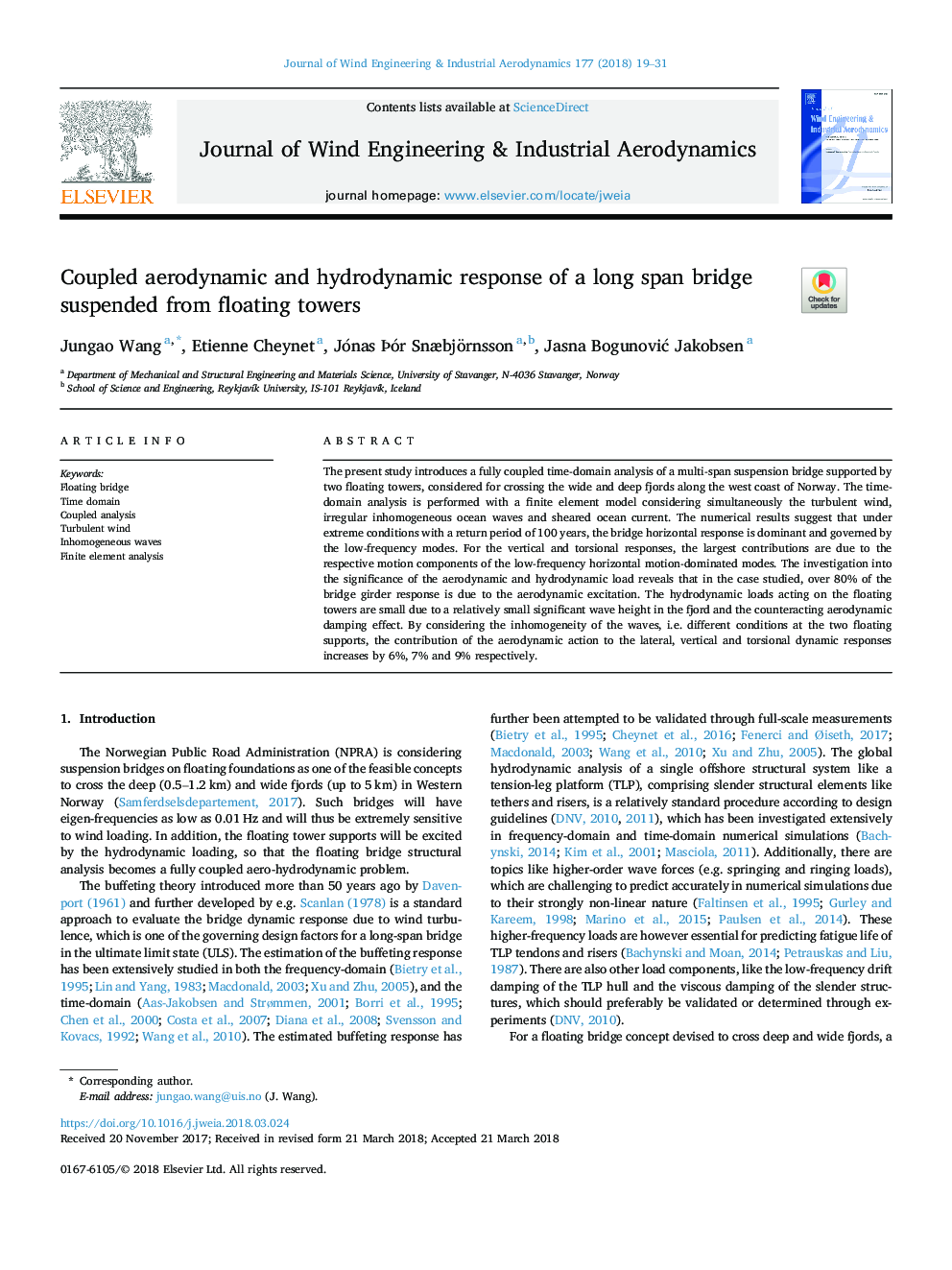| کد مقاله | کد نشریه | سال انتشار | مقاله انگلیسی | نسخه تمام متن |
|---|---|---|---|---|
| 6756860 | 1431089 | 2018 | 13 صفحه PDF | دانلود رایگان |
عنوان انگلیسی مقاله ISI
Coupled aerodynamic and hydrodynamic response of a long span bridge suspended from floating towers
ترجمه فارسی عنوان
پاسخ آیرودینامیک و هیدرودینامیکی همراه با یک پل طولانی طول از برج های شناور به حالت تعلیق درآمده است
دانلود مقاله + سفارش ترجمه
دانلود مقاله ISI انگلیسی
رایگان برای ایرانیان
کلمات کلیدی
پل شناور دامنه زمان، تحلیل تلفیقی، باد آشفته امواج غیرمجاز، تجزیه و تحلیل عنصر محدود،
ترجمه چکیده
در این مطالعه، یک تحلیل زمانی کاملا یکپارچه از یک پل تعلیق چند لبه پشتیبانی شده توسط دو برج شناور، برای عبور از فجورهای وسیع و عمیق در ساحل غربی نروژ مورد استفاده قرار می گیرد. تجزیه و تحلیل زمان محدوده با یک مدل عنصر محدود انجام می شود که به طور همزمان با توجه به باد آشفته، امواج ناهمگن اقیانوس نامنظم و جریان اقیانوس بریده می شود. نتایج عددی نشان می دهد که در شرایط شدید با دوره بازگشت 100 سال، پاسخ افقی پل غالب است و توسط فرکانس پایین فرکانس تنظیم می شود. برای پاسخهای عمودی و چرخشی، بزرگترین مشارکتها به علت اجزای حرکتی مرتبط با حالت افقی حرکتی افقی پایین با فرکانس پایین است. بررسی اهمیت بارهای آیرودینامیکی و هیدرودینامیکی نشان می دهد که در موارد مورد مطالعه بیش از 80٪ پاسخ پل های پل به علت تحریک آیرودینامیکی است. بارهای هیدرودینامیکی که بر روی برجهای شناور تاثیر می گذارند، به علت کم ارتفاع موج قابل توجهی در فجردر و اثر مضر آیرودینامیکی ضد آن است. با در نظر گرفتن ناهماهنگی امواج، یعنی شرایط مختلف در دو پشتیبانی شناور، سهم اثر آیرودینامیکی نسبت به پاسخ های پویای جانبی، عمودی و توریسیس به ترتیب 6٪، 7٪ و 9٪ افزایش می یابد.
موضوعات مرتبط
مهندسی و علوم پایه
مهندسی انرژی
انرژی های تجدید پذیر، توسعه پایدار و محیط زیست
چکیده انگلیسی
The present study introduces a fully coupled time-domain analysis of a multi-span suspension bridge supported by two floating towers, considered for crossing the wide and deep fjords along the west coast of Norway. The time-domain analysis is performed with a finite element model considering simultaneously the turbulent wind, irregular inhomogeneous ocean waves and sheared ocean current. The numerical results suggest that under extreme conditions with a return period of 100 years, the bridge horizontal response is dominant and governed by the low-frequency modes. For the vertical and torsional responses, the largest contributions are due to the respective motion components of the low-frequency horizontal motion-dominated modes. The investigation into the significance of the aerodynamic and hydrodynamic load reveals that in the case studied, over 80% of the bridge girder response is due to the aerodynamic excitation. The hydrodynamic loads acting on the floating towers are small due to a relatively small significant wave height in the fjord and the counteracting aerodynamic damping effect. By considering the inhomogeneity of the waves, i.e. different conditions at the two floating supports, the contribution of the aerodynamic action to the lateral, vertical and torsional dynamic responses increases by 6%, 7% and 9% respectively.
ناشر
Database: Elsevier - ScienceDirect (ساینس دایرکت)
Journal: Journal of Wind Engineering and Industrial Aerodynamics - Volume 177, June 2018, Pages 19-31
Journal: Journal of Wind Engineering and Industrial Aerodynamics - Volume 177, June 2018, Pages 19-31
نویسندگان
Jungao Wang, Etienne Cheynet, Jónas Ãór Snæbjörnsson, Jasna BogunoviÄ Jakobsen,
